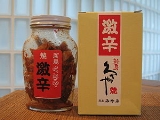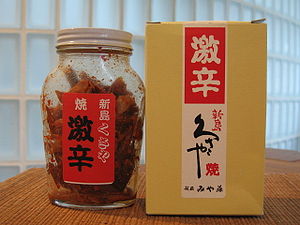
Kusaya
Encyclopedia

Marmite
Marmite is the name given to two similar food spreads: the original British version, first produced in the United Kingdom and later South Africa, and a version produced in New Zealand...
and blue cheese
Blue cheese
Blue cheese is a general classification of cow's milk, sheep's milk, or goat's milk cheeses that have had cultures of the mold Penicillium added so that the final product is spotted or veined throughout with blue, blue-gray or blue-green mold, and carries a distinct smell, either from that or...
and even more like Swedish surströmming
Surströmming
Surströmming herring") is a northern Swedish dish consisting of fermented Baltic herring. Surströmming is sold in cans, which often bulge during shipping and storage, due to the continued fermentation. When opened, the contents release a strong and sometimes overwhelming odor, which explains why...
.
Taste
Though the smell of kusaya is strong, its taste is quite mellow. Kusaya is often eaten with Japanese sake or shōchūShochu
is a Japanese distilled beverage. It is typically distilled from barley, sweet potatoes, or rice, though it is sometimes produced from other ingredients such as brown sugar, buckwheat or chestnut. Typically shōchū contains 25% alcohol by volume...
, particularly a local drink called Shima Jiman - island pride. The brine used to make kusaya, which includes many vitamins and organic acids such as acetic acid, propionic acid and amino acid, contributes much nutritional value to the resulting dried fish.
History
Kusaya originated in the Izu IslandsIzu Islands
The are a group of volcanic islands stretching south and east from the Izu Peninsula of Honshū, Japan. Administratively, they form two towns and six villages; all part of Tokyo. The largest is Izu Ōshima, usually called simply Ōshima....
, probably on Niijima, where, during the Edo period
Edo period
The , or , is a division of Japanese history which was ruled by the shoguns of the Tokugawa family, running from 1603 to 1868. The political entity of this period was the Tokugawa shogunate....
people used to earn a living through salt making. Villagers paid taxes to the government with the salt they made, and as taxes were high, salt for fish-curing was used frugally. The same salt was used many times for this purpose, resulting in a stinky dried fish, which was later called kusaya. The resulting, tea-colored, sticky, stinky brine was passed on from generation to generation as a family heirloom, as it were. Though kusaya is made on several of the Izu Islands today, it is said that kusaya from Niijima has the strongest odor.
Making kusaya
Mackerel scadMackerel scad
The Mackerel scad, Decapterus macarellus, is a species of fish of the family, Carangidae. While Mackerel scad are considered gamefish, they are usually used as bait.-Description:...
(Decapterus macarellus), flying fish and other similar species are used to make kusaya. The fish is washed in clear water many times before being soaked in a brine called Kusaya eki (くさや液, literally "Kusaya liquid" or "Kusaya juice") for eight to twenty hours. This mixture has a salt concentration of 8%, compared to the concentration of 18% to 20% in common fish curing brines. After this process the fish are laid out under the sun to dry for one to two days. The Niijima-Mura Museum on Niijima has several installations, including a video, on the making of kusaya.

